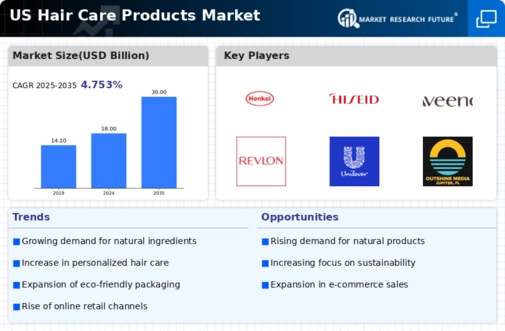Rising Awareness of Scalp Health
The hair care-products market is witnessing a growing recognition of the importance of scalp health, which is increasingly seen as integral to overall hair wellness. Consumers are becoming more educated about the role of scalp care in preventing hair issues such as dandruff and hair loss. Recent studies suggest that nearly 50% of consumers in the US are now incorporating scalp treatments into their hair care routines. This trend is prompting brands to develop specialized products that cater to scalp health, thereby expanding their product lines. The hair care-products market is thus adapting to this shift, with an emphasis on formulations that promote both scalp and hair health, potentially leading to increased consumer engagement.
Growth of Personalized Hair Care Solutions
The hair care-products market is increasingly leaning towards personalization, as consumers seek products tailored to their specific hair types and concerns. This trend is supported by advancements in technology, allowing brands to offer customized solutions based on individual needs. For instance, surveys indicate that over 60% of consumers in the US express interest in personalized hair care products. This shift towards customization is prompting companies to invest in research and development, leading to innovative formulations that address diverse hair issues. The hair care-products market is thus evolving, with brands that successfully implement personalized offerings likely to capture a larger share of the market.
Increasing Demand for Sustainable Products
The hair care-products market is experiencing a notable shift towards sustainability, driven by consumer preferences for eco-friendly and ethically sourced ingredients. A significant % of consumers in the US are willing to pay a premium for products that align with their values regarding environmental responsibility. This trend is prompting brands to innovate and reformulate their offerings, incorporating biodegradable packaging and natural ingredients. The hair care-products market is thus adapting to these demands, with many companies committing to sustainability goals. As a result, the market is likely to see a rise in the availability of products that not only cater to hair health but also minimize environmental impact, potentially leading to increased market share for brands that prioritize sustainability.
Expansion of Retail Channels and Accessibility
The hair care-products market is benefiting from the expansion of retail channels, enhancing product accessibility for consumers. Traditional brick-and-mortar stores are increasingly complemented by online platforms, allowing consumers to purchase products conveniently. Recent data indicates that online sales of hair care products have surged, accounting for a significant % of total sales in the market. This trend is encouraging brands to optimize their distribution strategies, ensuring that products are readily available across various platforms. The hair care-products market is thus evolving, with a focus on improving accessibility and convenience for consumers, which may lead to increased market penetration and sales growth.
Influence of Social Media and Beauty Influencers
The hair care-products market is significantly influenced by social media platforms, where beauty influencers play a crucial role in shaping consumer preferences. With millions of followers, these influencers often showcase hair care routines and product reviews, creating a direct impact on purchasing decisions. According to recent data, approximately 70% of consumers in the US report that social media influences their choice of hair care products. This trend indicates that brands must engage in strategic partnerships with influencers to enhance visibility and credibility. The hair care-products market is thus witnessing a surge in targeted marketing campaigns that leverage social media, potentially leading to increased sales and brand loyalty.




















Leave a Comment